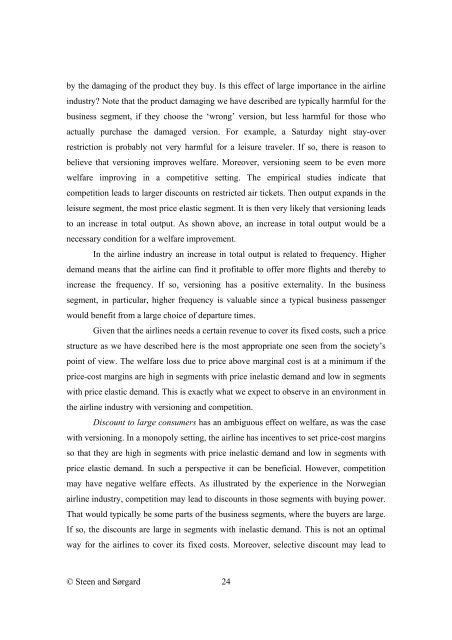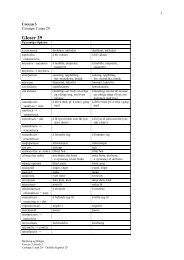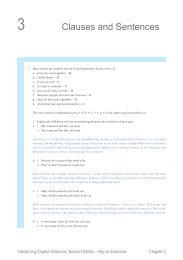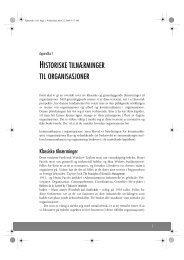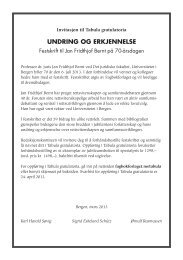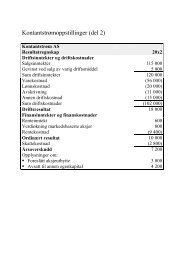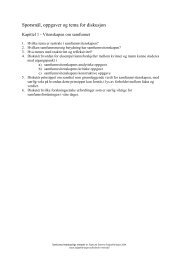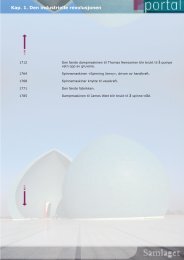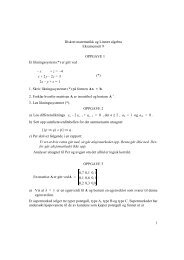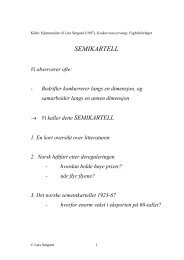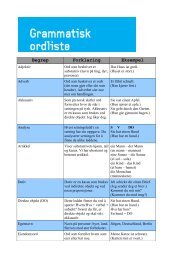price discrimination in the airline industry - Fagbokforlaget
price discrimination in the airline industry - Fagbokforlaget
price discrimination in the airline industry - Fagbokforlaget
Create successful ePaper yourself
Turn your PDF publications into a flip-book with our unique Google optimized e-Paper software.
y <strong>the</strong> damag<strong>in</strong>g of <strong>the</strong> product <strong>the</strong>y buy. Is this effect of large importance <strong>in</strong> <strong>the</strong> airl<strong>in</strong>e<strong>in</strong>dustry? Note that <strong>the</strong> product damag<strong>in</strong>g we have described are typically harmful for <strong>the</strong>bus<strong>in</strong>ess segment, if <strong>the</strong>y choose <strong>the</strong> ‘wrong’ version, but less harmful for those whoactually purchase <strong>the</strong> damaged version. For example, a Saturday night stay-overrestriction is probably not very harmful for a leisure traveler. If so, <strong>the</strong>re is reason tobelieve that version<strong>in</strong>g improves welfare. Moreover, version<strong>in</strong>g seem to be even morewelfare improv<strong>in</strong>g <strong>in</strong> a competitive sett<strong>in</strong>g. The empirical studies <strong>in</strong>dicate thatcompetition leads to larger discounts on restricted air tickets. Then output expands <strong>in</strong> <strong>the</strong>leisure segment, <strong>the</strong> most <strong>price</strong> elastic segment. It is <strong>the</strong>n very likely that version<strong>in</strong>g leadsto an <strong>in</strong>crease <strong>in</strong> total output. As shown above, an <strong>in</strong>crease <strong>in</strong> total output would be anecessary condition for a welfare improvement.In <strong>the</strong> airl<strong>in</strong>e <strong>in</strong>dustry an <strong>in</strong>crease <strong>in</strong> total output is related to frequency. Higherdemand means that <strong>the</strong> airl<strong>in</strong>e can f<strong>in</strong>d it profitable to offer more flights and <strong>the</strong>reby to<strong>in</strong>crease <strong>the</strong> frequency. If so, version<strong>in</strong>g has a positive externality. In <strong>the</strong> bus<strong>in</strong>esssegment, <strong>in</strong> particular, higher frequency is valuable s<strong>in</strong>ce a typical bus<strong>in</strong>ess passengerwould benefit from a large choice of departure times.Given that <strong>the</strong> airl<strong>in</strong>es needs a certa<strong>in</strong> revenue to cover its fixed costs, such a <strong>price</strong>structure as we have described here is <strong>the</strong> most appropriate one seen from <strong>the</strong> society’spo<strong>in</strong>t of view. The welfare loss due to <strong>price</strong> above marg<strong>in</strong>al cost is at a m<strong>in</strong>imum if <strong>the</strong><strong>price</strong>-cost marg<strong>in</strong>s are high <strong>in</strong> segments with <strong>price</strong> <strong>in</strong>elastic demand and low <strong>in</strong> segmentswith <strong>price</strong> elastic demand. This is exactly what we expect to observe <strong>in</strong> an environment <strong>in</strong><strong>the</strong> airl<strong>in</strong>e <strong>in</strong>dustry with version<strong>in</strong>g and competition.Discount to large consumers has an ambiguous effect on welfare, as was <strong>the</strong> casewith version<strong>in</strong>g. In a monopoly sett<strong>in</strong>g, <strong>the</strong> airl<strong>in</strong>e has <strong>in</strong>centives to set <strong>price</strong>-cost marg<strong>in</strong>sso that <strong>the</strong>y are high <strong>in</strong> segments with <strong>price</strong> <strong>in</strong>elastic demand and low <strong>in</strong> segments with<strong>price</strong> elastic demand. In such a perspective it can be beneficial. However, competitionmay have negative welfare effects. As illustrated by <strong>the</strong> experience <strong>in</strong> <strong>the</strong> Norwegianairl<strong>in</strong>e <strong>in</strong>dustry, competition may lead to discounts <strong>in</strong> those segments with buy<strong>in</strong>g power.That would typically be some parts of <strong>the</strong> bus<strong>in</strong>ess segments, where <strong>the</strong> buyers are large.If so, <strong>the</strong> discounts are large <strong>in</strong> segments with <strong>in</strong>elastic demand. This is not an optimalway for <strong>the</strong> airl<strong>in</strong>es to cover its fixed costs. Moreover, selective discount may lead to© Steen and Sørgard 24


